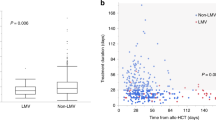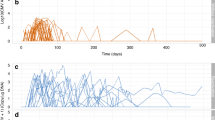Abstract
Prophylactic use of letermovir (LMV) markedly reduces the incidence of early clinically significant cytomegalovirus (csCMV) infection within the first 100 days after allogeneic hematopoietic cell transplantation (allo-HCT), which improves transplant outcomes. However, some patients eventually develop late-csCMV infection (beyond day 100) after completing LMV prophylaxis. To assess the incidence of late-csCMV infection as well as its risk factors and impacts on transplant outcome, a total of 81 allo-HCT recipients who had not developed early csCMV infection during LMV prophylaxis were retrospectively analyzed. Among them, 23 (28.4%) patients developed late-csCMV infection (until day 180) at a median time of 131 days after transplantation and 30 days after LMV discontinuation, respectively. Late-csCMV infection was correlated with apparent delayed immune reconstitution: patients transplanted from HLA-mismatched donors (hazard ratio [HR] = 13.0, p = 0.011) or CMV-IgG-negative donors (HR = 2.39, p = 0.043) had a significantly higher risk. In this study, transplant outcomes did not differ between patients with and without late-csCMV infection. This suggests a need to clarify the efficacy of extended administration of LMV for preventing late-csCMV infection in a larger number of allo-HCT recipients, especially those with “high-risk” donors.


Similar content being viewed by others
References
Chang YJ, Zhao XY, Huo MR, Xu LP, Liu DH, Liu KY, et al. Immune reconstitution following unmanipulated HLA-mismatched/haploidentical transplantation compared with HLA-identical sibling transplantation. J Clin Immunol. 2012;32:268–80.
Raiola AM, Dominietto A, Di Grazia C, Lamparelli T, Gualandi F, Ibatici A, et al. Unmanipulated haploidentical transplants compared with other alternative donors and matched sibling grafts. Biol Blood Marrow Transplant. 2014;20:1573–9.
Slade M, Goldsmith S, Romee R, DiPersio JF, Dubberke ER, Westervelt P, et al. Epidemiology of infections following haploidentical peripheral blood hematopoietic cell transplantation. Transpl Infect Dis. 2017;19: e12629.
Lin CH, Su YJ, Hsu CY, Wang PN, Teng CJ. Haploidentical allogeneic hematopoietic stem cell transplantation increases the risk for cytomegalovirus infection in adult patients with acute leukemia. Transpl Infect Dis. 2019;21: e13096.
Ljungman P, Brand R, Hoek J, de la Camara R, Cordonnier C, Einsele H, et al. Donor cytomegalovirus status influences the outcome of allogeneic stem cell transplant: a study by the European Group for Blood and Marrow Transplantation. Clin Infect Dis. 2014;59:473–81.
Teira P, Battiwalla M, Ramanathan M, Barrett AJ, Ahn KW, Chen M, et al. Early cytomegalovirus reactivation remains associated with increased transplant related mortality in the current era: a CIBMTR analysis. Blood. 2016;127:2427–38.
Takenaka K, Nishida T, Asano-Mori Y, Oshima K, Ohashi K, Mori T, et al. Cytomegalovirus reactivation after allogeneic hematopoietic stem cell transplantation is associated with a reduced risk of relapse in patients with acute myeloid leukemia who survived to day 100 after transplantation: the Japan Society for Hematopoietic Cell Transplantation transplantation-related complication working group. Biol Blood Marrow Transplant. 2015;21:2008–16.
Borst EM, Kleine-Albers J, Gabaev I, Babic M, Wagner K, Binz A, et al. The human cytomegalovirus UL51 protein is essential for viral genome cleavage-packaging and interacts with the terminase subunits pUL56 and pUL89. J Virol. 2013;87:1720–32.
Goldner T, Hewlett G, Ettischer N, Ruebsamen-Schaeff H, Zimmermann H, Lischka P. The novel anti-cytomegalovirus compound AIC246 (Letermovir) inhibits human cytomegalovirus replication through a specific antiviral mechanism that involves the viral terminase. J Virol. 2011;85:10884–93.
Marty FM, Ljungman P, Chemaly RF, Maertens J, Dadwal SS, Duarte RF, et al. Letermovir prophylaxis for cytomegalovirus in hematopoietic-cell transplantation. N Engl J Med. 2017;377:2433–44.
Ljungman P, de la Camara R, Robin C, Crocchiolo R, Einsele H, Hill JA, et al. Guidelines for the management of cytomegalovirus infection in patients with haematological malignancies and after stem cell transplantation from the 2017 European Conference on Infections in Leuekmia (ECIL-7). Lancet Infect Dis. 2019;19:e260–72.
Lin A, Maloy M, Su Y, Bhatt V, DeRespiris L, Griffin M, et al. Letermovir for primary and secondary cytomegalovirus prevention in allogeneic hematopoietic cell transplant recipients: real-world experience. Transpl Infect Dis. 2019;4: e13187.
Sharma P, Gakhar N, MacDonald J, Abidi MZ, Benamu E, Bajrovic V, et al. Letermovir prophylaxis through day 100 post transplant is safe and effective compared with alternative CMV prophylaxis strategies following adult cord blood and haploidentical cord blood transplantation. Bone Marrow Transplant. 2020;55:780–6.
Lin A, Flynn J, DeRespiris L, Figgins B, Griffin M, Lau C, et al. Letermovir for prevention of cytomegalovirus reactivation in haploidentical and mismatched adult donor allogeneic hematopoietic cell transplantation with post-transplantation cyclophosphamide for graft-versus-host disease prophylaxis. Biol Blood Marrow Transplant. 2021;27(85):e1–6.
Mori Y, Jinnouchi F, Takenaka K, Aoki T, Kuriyama T, Kadowaki M, et al. Efficacy of prophylactic letermovir for cytomegalovirus reactivation in hematopoietic cell transplantation: a multicenter real-world data. Bone Marrow Transplant. 2021;56:853–62 (Online ahead of print).
Derigs P, Radujkovic A, Schubert ML, Schnitzler P, Schoning T, Muller-Tidow C, et al. Letermovir prophylaxis is effective in preventing cytomegalovirus reactivation after allogeneic hematopoietic cell transplantation: single-center real-world dara. Ann Hematol. 2021;100:2087–93 (Online ahead of print).
Zamora D, Akoto B, Xie H, Kiener R, Edmison BC, Stevens-Ayers T, et al. Cytomegalovirus (CMV)-specific polyfunctional T-cell responses after letermovir (LET) prophylaxis in hematopoietic cell transplantation (HCT). Biol Blood Marrow Transplant. 2020;26:S68–9 (abstract).
Bansal R, Gordillo CA, Abramova R, Assal A, Mapara MY, Pereira MR, et al. Extended letermovir administration, beyond day 100, is effective for CMV prophylaxis in patients with graft-versus-host disease. Transpl Infect Dis. 2020;23: e13487 (Online ahead of print).
Styczynski J, Tridello G, Xhaard A, Medinger M, Mielke S, Taskinen M, et al. Use of letermovir in off-label indications: Infectious Diseases Working Party of European Society of Blood and Marrow Transplantation retrospective study. Bone Marrow Transplant. 2020;56(5):1171–9 (Online ahead of print).
Robin C, Thiebaut A, Alain S, de Fontbrune FS, Berceanu A, D’Aveni M, et al. Letermovir for secondary prophylaxis of cytomegalovirus infection and disease after allogeneic hematopoietic cell transplantation: results from the French Compassionate Program. Biol Blood Marrow Transplant. 2020;26:978–84.
Hakki M, Riddell SR, Storek J, Carter RA, Stevens-Ayers T, Sudour P, et al. Immune reconstitution to cytomegalovirus after allogeneic hematopoietic stem cell transplantation: impact of host factors, drug therapy, and subclinical reactivation. Blood. 2003;102:3060–7.
Boeckh M, Leisenring W, Riddell SR, Bowden RA, Huang ML, Myerson D, et al. Late cytomegalovirus disease and mortality in recipients of allogeneic hematopoietic stem cell transplants: importance of viral load and T-cell immunity. Blood. 2003;101:407–14.
Ljungman P, Griffiths P, Paya C. Definitions of cytomegalovirus infection and disease in transplant recipients. Clin Infect Dis. 2002;34:1094–7.
Kanda Y. Investigation of the freely available easy-to-use software “EZR” for medical statistics. Bone Marrow Trasnplant. 2013;48:452–8.
Yokoyama H, Kanda J, Kato S, Kondo E, Maeda Y, Saji H, et al. Effects of HLA mismatch on cytomegalovirus reactivation in cord blood transplantation. Bone Marrow Transplant. 2019;54:1004–12.
Klein AK, Patel DD, Gooding ME, Sempowski GD, Chen BJ, Liu C, et al. T-cell recovery in adults and children following umbilical cord blood transplantation. Biol Blood Marrow Transplant. 2001;7:454–66.
Komanduri KV, St John LS, de Lima M, McMannis J, Rosinski S, McNiece I, et al. Delayed immune reconstitution after cord blood transplantation is characterized by impaired thymopoiesis and late memory T-cell skewing. Blood. 2007;110:4543–51.
Jameson SC. Maintaining the norm: T-cell homeostatis. Nat Rev Immunol. 2002;2:547–56.
Kanda J, Chiou LW, Szabolcs P, Sempowski GD, Rizzieri DA, Long GD, et al. Immune recovery in adult patients after myeloablative dual umbilical cord blood, matched sibling, and matched unrelated donor hematopoietic cell transplantation. Biol Blood Marrow Transplant. 2012;18:1664–76.
Brown JA, Stevenson KE, Kin HT, Cutler C, Ballen K, McDonough SM, et al. Clearance of CMV viremia and survival after double umbilical cord blood transplantation in adults depends on reconstitution of thymopoiesis. Blood. 2010;115:4111–9.
Jacobson CA, Turki AT, McDonough SM, Stevenson KE, Kin HT, Kao G, et al. Immune reconstitution after double umbilical cord blood stem cell transplantation: comparison with unrelated peripheral blood stem cell transplantation. Biol Blood Marrow Transplant. 2012;18:565–74.
Clave E, Lisini D, Douay C, Giorgiani G, Busson M, Zecca M, et al. Thymic function recovery after unrelated donor cord blood or T-cell depleted HLA-haploidentical stem cell transplantation correlates with leukemia relapse. Front Immunol. 2013;4:54.
Hill JA, Zamora D, Xie H, Thur LA, Delaney C, Dahlberg A, et al. Delayed-onset cytomegalovirus infection is frequent after discontinuing letermovir in cord blood transplant recipients. Blood Adv. 2021;5:3113–9.
Ljungman P, Peres-Bercoff L, Jonsson J, Avetisyan G, Sparrelid E, Aschan J, et al. Risk factors for the development of cytomegalovirus disease after allogeneic stem cell transplantation. Haematologica. 2006;91:78–83.
Webb BJ, Harrington R, Schwartz J, Kammerer J, Spalding J, Lee E, et al. The clinical and economic impact of cytomegalovirus infection in recipients of hematopoietic stem cell transplantation. Transpl Infect Dis. 2018;20: e12961.
Cwynarski K, Ainsworth J, Cobbold M, Wagner S, Mahendra P, Apperley J, et al. Direct visualization of cytomegalovirus-specific T-cell reconstitution after allogeneic stem cell transplantation. Blood. 2001;97:1232–40.
Zhou W, Longmate J, Lacey SF, Palmer JM, Gallez-Hawkins G, Thao L, et al. Impact of donor CMV status on viral infection and reconstitution of multifunction CMV-specific T cells in CMV-positive transplant recipients. Blood. 2009;113:6465–76.
Gratama JW, Boeckh M, Nakamura R, Cornelissen JJ, Brooimans RA, Zaia JA, et al. Immune monitoring with iTAg MHC Tetramers for prediction of recurrent or persistent cytomegalovirus infection or disease in allogeneic hematopoietic stem cell transplant recipients: a prospective multicenter study. Blood. 2010;116:1655–62.
Toya T, Taguchi A, Kitaura K, Misumi F, Nakajima Y, Otsuka Y, et al. T-cell receptor repertoire of cytomegalovirus-specific cytotoxic T cells after allogeneic stem cell transplantation. Sci Rep. 2020;10:22218.
Acknowledgements
The authors would like to thank the medical and nursing staff who cared for the patients at the Kyushu University Hospital and provided patients information.
Author information
Authors and Affiliations
Corresponding author
Ethics declarations
Conflict of interest
K.A. and T.M. received honoraria from MSD Co., Ltd. The other authors have no conflicts of interests to declare.
Additional information
Publisher's Note
Springer Nature remains neutral with regard to jurisdictional claims in published maps and institutional affiliations.
About this article
Cite this article
Mori, Y., Harada, T., Yoshimoto, G. et al. Risk factors for late cytomegalovirus infection after completing letermovir prophylaxis. Int J Hematol 116, 258–265 (2022). https://doi.org/10.1007/s12185-022-03348-2
Received:
Revised:
Accepted:
Published:
Issue Date:
DOI: https://doi.org/10.1007/s12185-022-03348-2




